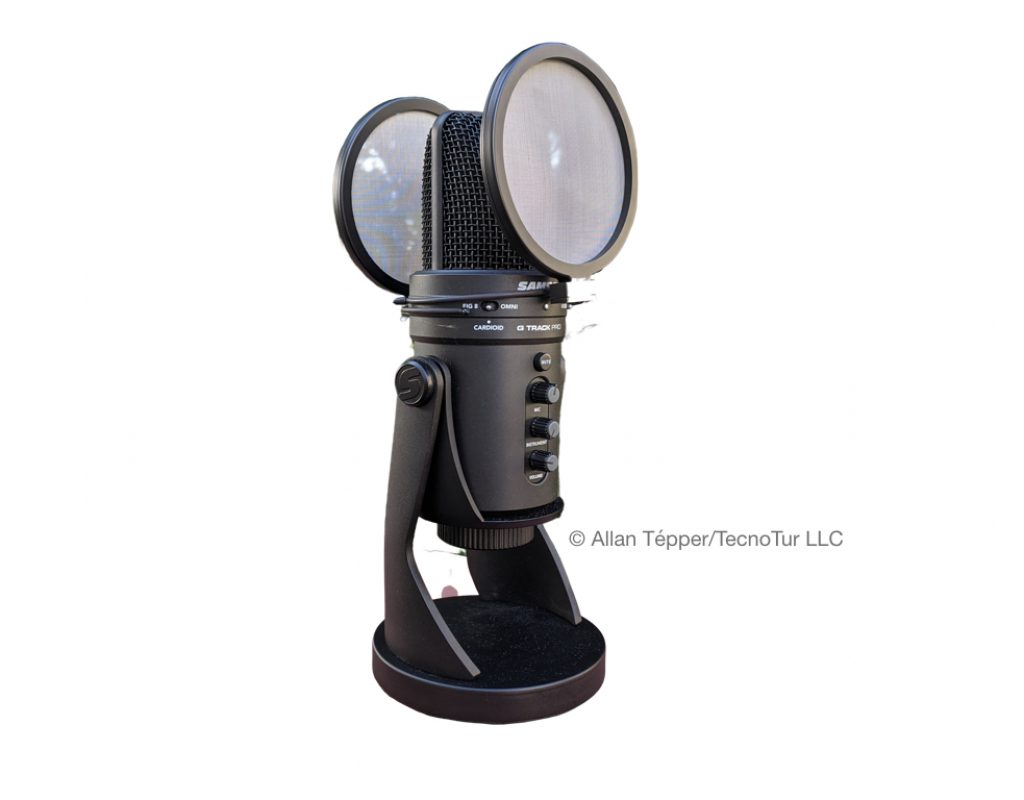Here is my review of the Samson G-Track Pro large-diaphragm multi pattern microphone with optional G-Track Pro Pop Filters, which are also from Samson. I had seen so many reviews where the G-Track Pro sounded great, but suffered from severe plosives, I was anxious to try it with the matching G-Track Pro pop filters (two of them). I needed two for use with another person with the Figure 8 pattern. Read ahead to learn how this mic interfaces via USB with a standard computer, required workarounds to use it with different mobile devices, how it sounds with different pickup patterns and situations, and how its inboard latency-free monitoring works.
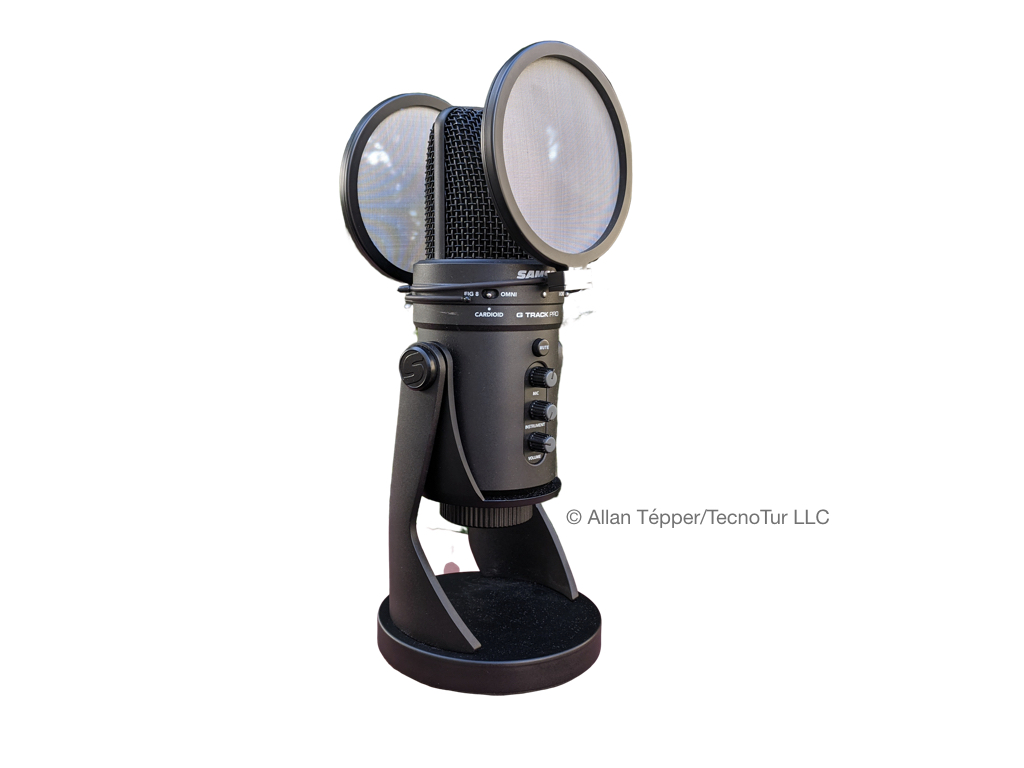
Multiplatform compatibility, connections and power
Samson officially offers the G-Track Pro (≈US$130 in black , Amazon — B&H… or US$99 in silver, B&H exclusive version) to be compatible with macOS and Windows. All of my test recordings you’ll hear ahead are made with a laptop running macOS Mojave 10.14.6. I suspect that the G-Track Pro will also work fine with Chromebooks too, as I have used several other USB microphones and interfaces with Chromebooks with no problems.
- To use the G-Track Pro with a modern Android device with USB-C connection, you would need to use a powered USB hub, since the maximum electrical current available on most Android devices is likely too low. This was the case with my Google Pixel XL telephone with USB-C. Even if it did work with your Android device, the G-Track Pro would drain the iPad Pro’s battery very quickly.
- To use the G-Track Pro with an older Android device with an older USB connection (with Android version 9 or later), you can use the included USB-C <>USB-A cable together with an OTG Y-adapter to connect from USB-A female to the USB connector on your phone (often Micro USB and infrequently with Mini USB). The reason to use an OTG Y-adapter is to be able to provide higher electricity current than your phone is likely able to send over USB.
- To use the G-Track Pro with a very modern iOS device wish USB-Clike the iPad Pro 2018 (the first iOS device to be shipped with USB-C), it’s best to use a powered USB-C hub or dock. I did not have an iPad Pro 2018 to test, but that will give you the best results, since even if it did work without it, the G-Track Pro would drain the iPad Pro’s battery very quickly. For many reasons that go beyond the scope of this article, it is very likely that all new iPad Pro models starting in 2020 will use USB-C, and they will likely trickle down to certain upcoming non-Pro iPads and iPhones.
- To use the G-Track Pro with an iOS device with a Lightning connector, Samson specifically recommends an Apple Lightning to USB 3 Camera Adapter with the passthrough power connector connected to some external power source.
- To use the G-Track Pro with a standard computer with a USB-A connector, be it laptop or desktop (ChromeOS, macOS or Windows), simply use the included USB-B<>USB-A cable.
- To use the G-Track Pro with a standard computer with a USB-C connector, be it laptop or deskktop (ChromeOS, macOS or Windows), use an optional USB-B<>USB-C cable, or the supplied cable with an adapter from USB-A female to USB-C male.
As you’ll conclude, the the G-Track Pro offers a very smooth connection with conventional computers with any type of USB connection, but for tablets and phones, additional hardware and power is required.
G-Track Pro pickup patterns
- Cardioid
- Figure 8
- Omnidirectional (not tested)
External input for a line-level or instrument-level signal
This is the first time I have ever seen a microphone which has an input for a line-level or instrument-level signal. This feature is best used by musicians, and I did not test it, but some other reviewers have. To use it, you would switch the Mono/2-Track switch to the latter position. As I’ll cover later in this article, even when in the “Mono” position, like many other mono USB microphones, the G-Track Pro actually presents itself to the system as “stereo”, with the same identical signal on both track. When in the 2 Track position, it sends the G-Track Pro’s microphone signal to one track, and the line-level or instrument-level source on the other.
Available sampling rates and resolutions
I am happy with the variety of sampling rates and resolutions available in the G-Track Pro, although I only tested using our standard 48 kHz/24-bit (see Enter the 48 kHz alliance).
The G-Track Pro can go up to 96 kHz/ 24-bit. (96 is exactly 48×2.) I could only justify recording such a high a sampling frequency for vocal recordings if you plan to use slow motion as you edit your audio recordings (or audio/video recordings). In addition to our standard 48 kHz and the whopping 92 khz, the G-TRACK Pro also offers 44.1 kHz (which I would never use for the reasons stated in Enter the 48 kHz Alliance), and 88.2 kHz (which I would never use either, since it isn’t a multiple of 48, but of the dreaded 44.1 kHz).
As I have covered in prior articles, to set your audio sampling on Android or iOS, simply select it in any of the recording apps that offer such an audio sampling selection (i.e. Auphonic, FiLMiC Pro, FV-5 Cinema) or use an app that uses 48 kHz exclusively, like the RØDE Reporter app. (Stay away from the native camera app or GarageBand, which only support 44.1 kHz, which is kryptonite for video production.)
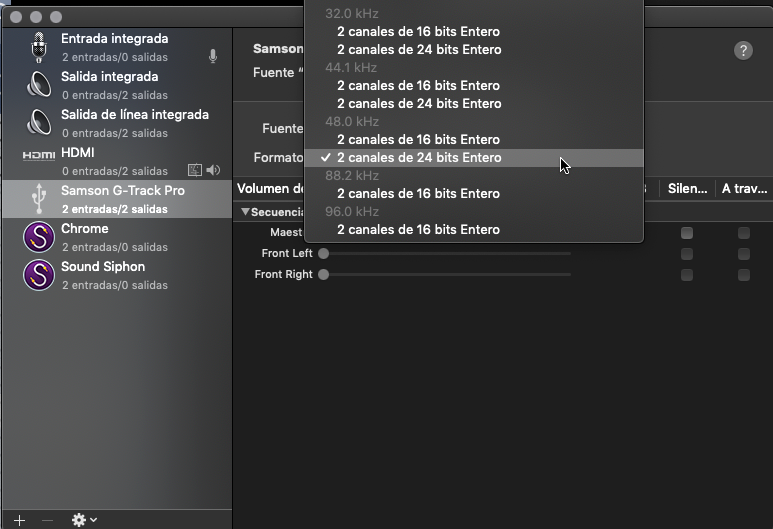
On macOS, first select in the Audio MIDI Setup (illustrated above) and then in your desired recording app,

which must not be GarageBand. See my 2015 article 48 reasons why GarageBand is kryptonite for video production illustrated above.
Bulletproof and strong latency-free monitoring
The G-Track Pro’s 3.5 mm jack for monitoring is designed to be used with either TRS stereo headphones or even with TRRS headphones with a microphone included. The G-Track Pro is fortunately designed to ignore the microphone on a TRRS headset, if present, while outputting the latency-free audio.
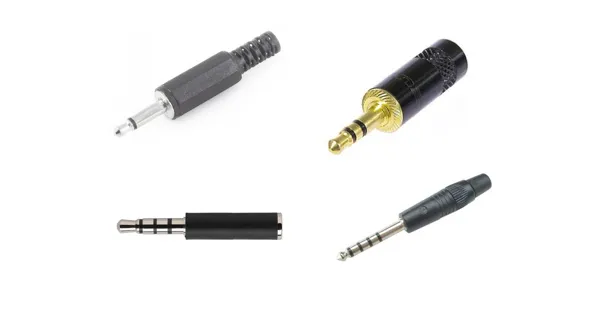
I call it bulletproof since it solves the issue discussed in my 2015 article TS/TRS/TRRS/TRRRS: Combating the misconnection epidemic (illustrated above).
The same 3.5 mm jack also works just as well for playback monitoring (or listening to a remote guest or panelist), as long as your app and system are set to send audio playback to the G-Track Pro.
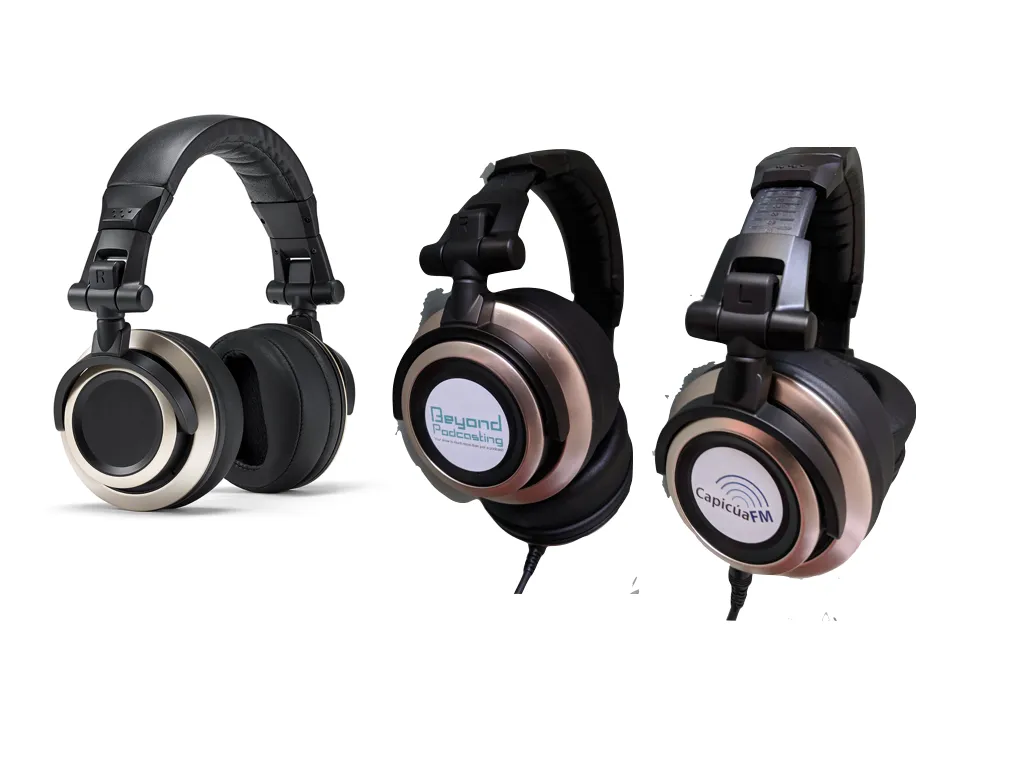
Unlike some other devices I have tested recently (which have a much weaker headphone amplifier), using my favorite CB-1 isolating headphones (which are rated at 32 ohms, shown above, reviewed here), the output level in my headphones fortunately was great even at about 11 (in clock nomenclature) on the volumen pot (potentiometer) for the headphones when recording at -12 dB and setting the headphones. Since the headphone amplifier in the G-Track Pro is so powerful, even the popular Sony MDR-7506 headphone (which is rated at 63 ohms) should be fine.
Tabletop base or optional shockmount
The G-Track Pro comes with a very heavy desk stand.

The only way to mount it onto a boom arm or mic stand is by purchasing an optional shockmount like Samson’s own SP04 (shown above, Amazon — B&H). Although I requested the SP04 shockmount together with the G-Track Pro for review with two pop filters, I did not receive the SP04 so I was unable to test it.
4K compatible Ultra-HD Audio?
Although Samsung did not use these terms when marketing the G-Track Pro the way some other mic manufacturers have, I would like to clarify how this fits into this description, even though I recommend using only 48 kHz for spoken word unless you plan to include slow-motion audio in your production.
- The now obsolete HD DVD format demands 48 kHz and permits up to 192 kHz audio sampling and 24-bit audio resolution, although the obsolete HD DVD is not 4K.
- Blu-ray or Blu-ray Disc (BD) demands 48 kHz and permits up to 192 kHz audio sampling and 24-bit audio resolution, but it is not 4K.
- Ultra-high-definition television (also known as Ultra HD television, Ultra HD, UHDTV, UHD and Super Hi-Vision) today includes 4K UHD and 8K UHD, which are two digital video formats with an aspect ratio of 16:9. These formats demand 48 kHz and permit up to 96 kHz audio sampling at 16/20/24 bit resolution.
- Amazon Ultra HD Audio Music supports up to 192 kHz audio sampling.
- Amazon Video Direct via Amazon Prime demands 48 kHz audio, as I covered in this article.
As covered earlier, the G-Track Pro can sample up to 96 kHz/24-bit, although for spoken word, I would only justify recording at higher than 48 kHz if you plan to use slow-motion audio in post-production.
How the G-Track Pro introduces itself to the system
Like most USB microphones I have tested previously (but not all), the G-Track Pro always introduces itself to the system as dual channel (“stereo”) even when in “mono” mode.
However, in order to save drive space and bandwidth when uploading a file, certain apps allow us to record in mono 48 kHz when recording from a “fake stereo” source. For example, in the Auphonic app for Android or iOS, just set Mono in the settings. In Hindenburg Journalist Pro (my favorite audio editing program for storytellers on standard computers, covered in many articles) is another audio program which gives us this option.
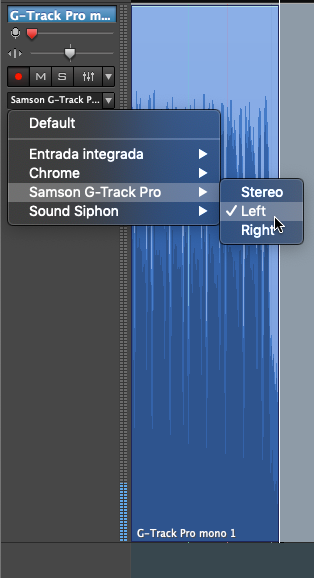
Above you’ll see how to do that in Hindenburg Journalist Pro (with your menus in English). Just choose either the “fake” Left or Right of the AKG Lyra when selecting the source. That way the recording will be half the size on your drive. In case you are wondering, Hindenburg Journalist Pro automatically treats recordings made this way as centered if exported or published in stereo. Below you’ll see it as it would appear if your menus are in Castilian (castellano), as mine usually are:
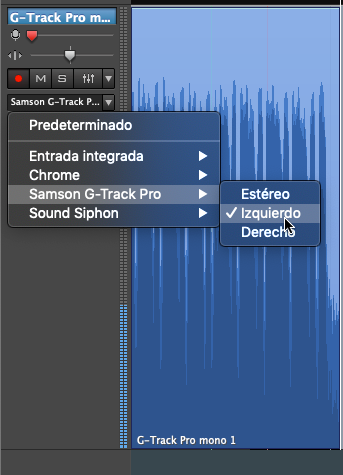
The Castilian word for Left is Izquierdo and the word for Right is Derecho.
Consistent pots (potentiometers)
There are three potentiometers on the G-Track Pro: in front is microphone gain, the Instrument (or line level) input gain, and the headphone volume. Whether they are actually controlling the levels directly or acting as remote controls for their respective inboard amplifier, they behave as the former, so the relative position is consistent. This means two advantages compared with many other devices which allow spinning infinitely. These are:
- They recall their positions even after powering down and powering up.
- Remembering how they are pointed in a given situation can offer consistent results.
I only wish there were numbers around the pots, or at least section markers.
Test recordings
All below recordings are uncompressed 48 kHz WAV. Use Ethernet, wifi or unmetered data.
Audio Player
Above, cardioid pattern, single voice, flat (other than normalization).
Audio Player
Above, cardioid pattern, single voice, with mild noise reduction from Hindenburg Journalist Pro.
Audio Player
Above, cardioid pattern, single voice, with mild noise reduction and mild dynamic compression from Hindenburg Journalist Pro.
Audio Player
Above, two voices (mine and Memo Sauceda’s), figure-8 pattern in an untreated living room, flat.
Audio Player
Above, two voices (mine and Memo Sauceda’s), figure-8 pattern in an untreated living room, with mild noise reduction from Hindenburg Journalist Pro.
Audio Player
Above, two voices (mine and Memo Sauceda’s), figure-8 pattern in an untreated living room, with CrumplePop EchoRemover (reviewed here) and mild noise reduction from Hindenburg Journalist Pro.
Where the Samson G-Track Pro is best used
The Samson G-Track Pro (≈US$130 in black , Amazon — B&H… or US$99 in silver, B&H exclusive version) is has extraordinary quality for its price (when protected by a good pop filter like the indicated one earlier in this article). However it is best used in the studio, not for travel, due to its very large size, weight and power requirements.
RATINGS
Looks and build quality

Connectivity for USB and standard computers

Connectivity for for mobile devices

This is due to the G-Track Pro’s high current consumption, which require external power and more adapters.
Zero-latency monitoring

(Loud enough for even higher-impedance headphones; allows hearing both the local microphone and remote return audio without switching back and forth to hear a remote guest or panelist.)
Sound quality in cardioid mode

(in its price range, using the aforementioned pop filter)
Sound quality in figure 8

(using the aforementioned windscreen)
Potentiometer behavior

(due to their consistency)
Photo credits
The main image of this article was taken and silhouetted by Allan Tépper.
Other images of the G-Track Pro are courtesy of Samson.
(Re-)Subscribe for upcoming articles, reviews, radio shows, books and seminars/webinars
Stand by for upcoming articles, reviews, books and courses. Sign up to my free mailing list by clicking here. If you previously subscribed to my bulletins and no longer receive them, you must re-subscribe due to new compliance to GDPR. Most of my current books are at books.AllanTepper.com, and my personal website is AllanTepper.com. Also visit radio.AllanTepper.com.
Si deseas suscribirte (o volver a suscribirte) a mi lista en castellano, visita aquí. Si prefieres, puedes suscribirte a ambas listas (castellano e inglés).
Suscribe to his BeyondPodcasting show at BeyondPodasting.com.
Subscribe to his To boldly split infinitives show at Toboldlysplitinfinitives.com.
Subscribe to his award-winning CapicúaFM show at CapicúaFM.com.
FTC disclosure
No manufacturer is specifically paying Allan Tépper or TecnoTur LLC to write this article or the mentioned books. Some of the other manufacturers listed above have contracted Tépper and/or TecnoTur LLC to carry out consulting and/or translations/localizations/transcreations. Many of the manufacturers listed above have sent Allan Tépper review units. So far, none of the manufacturers listed above is/are sponsors of the TecnoTur , BeyondPodcasting CapicúaFM or TuRadioGlobal programs, although they are welcome to do so, and some are, may be (or may have been) sponsors of ProVideo Coalition magazine. Some links to third parties listed in this article and/or on this web page may indirectly benefit TecnoTur LLC via affiliate programs. Allan Tépper’s opinions are his own. Allan Tépper is not liable for misuse or misunderstanding of information he shares.
Copyright and use of this article
The articles contained in the TecnoTur channel in ProVideo Coalitionmagazine are copyright Allan Tépper/TecnoTur LLC, except where otherwise attributed. Unauthorized use is prohibited without prior approval, except for short quotes which link back to this page, which are encouraged!

Filmtools
Filmmakers go-to destination for pre-production, production & post production equipment!
Shop Now